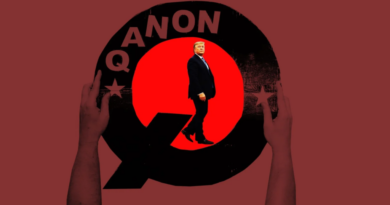What happened to QAnon?

“There’s a storm coming,” popular historian turned esoteric political commentator Neil Oliver posted on Twitter in May, “Maybe not today. Maybe not tomorrow. But there’s a storm coming.” As Mr. Oliver is a Scotsman who calls himself “the Coast Guy,” some of his followers might have thought he was referring to the weather. Others more acquainted with the tropes of modern conspiratorial thought, though, will see the reference to a “storm” as a reference to a time of social and political crisis. It comes — whether Mr. Oliver knows it or not — from the fevered discourse of QAnon.
QAnon! The term almost makes you feel nostalgic. Back in a more innocent age, when Donald Trump was in the White House, many followers of the 45th president convinced themselves that a government insider known as “Q” was communicating messages about Trump’s plan to defeat a cabal of Satanic child molesters which included Barack Obama, Hillary Clinton and George Soros. “Trust the plan,” QAnon believers would tell each other, in what now seems like a valiant attempt to convince themselves that Trump was actually doing something. “The Storm” was to be the moment when Trump would round up — and possibly execute — his political enemies.
As conspiracy theories went, it was quite a silly one — reveling in its own esotericism. Advocates of QAnon did not compile evidence as much as seize upon random data points that seemed menacing in their collective surrealism. The idea of “the storm,” for example, came from Trump’s once remarking “this is the calm before the storm” as he attended a dinner with military officials and their wives. Why, surely that could only mean that he was going to arrest Tom Hanks and Hillary Clinton.
Funny as it was, it was also dangerous. Several believers planned or carried out acts of violence. Matthew P. Wright of Nevada blocked the bridge over the Hoover Dam with a homemade armored truck and a bunch of weapons. In an unusually baroque conflation of mythologies, Anthony Comello somehow convinced himself that the mobster Frank Cali was a part of the “Deep State” and shot him to death outside his Staten Island home.
Jacob Chansley, the January 6 protester who invaded the Capitol in a bison-horned fur headdress, used to march around even before that with a sign that said “Q SENT ME!” Sadly, Q also let him go to prison. On other less sensational but very bleak occasions, QAnon tore up families as its followers descended into monomania.
QAnon drifted into relative irrelevance after Donald Trump’s 2020 election defeat. How could it not? Its believers had trusted the plan and the plan was for Joe Biden to… win? Huh? There was no “storm” or even so much as a breeze. Some believers drifted away, with the subreddit r/QAnonCasualties collecting disaffected emigrés.
But it still bubbled away beneath the surface. In 2021, according to the Public Religion Research Institute, more rather than fewer Americans (about 17 percent compared to about 14) declared themselves believers in the three core tenets of the movement: that the government, media and financial worlds in the US are controlled by a group of Satan-worshiping pedophiles who run a global child sex-trafficking operation; that there is a storm coming soon that will sweep away the elites in power and restore the rightful leaders; and that because things have gotten so far off track, true American patriots may have to resort to violence in order to save their country.
Now, with Trump plotting a second term, it could be QAnon’s time for a resurrection. The storm really is coming this time! The plan is back, baby! The 45th president has an interest in encouraging the movement, of course. Who were among his most dedicated advocates? The real ride-or-die MAGA-heads? That’s right — QAnon. And he does not even have to appeal to them directly. He can appeal to their love of esoteric symbolism. So, Trump has repeatedly “reTruthed” Q-linked messages on his social media platform and promoted an image of himself wearing a “Q” pin, overlaid with the words “The Storm Is Coming” and the dogwhistle initials WWG1WGA (“Where We Go One, We Go All”).
Meanwhile, QAnon has been going global. As Mr. Oliver’s tweet suggests, its tropes have been adopted by esoterically-minded dissidents across the world. In Germany, for example, popular Telegram groups have names like “Qlobal” and “QPatrioten24.” In the UK, WWG1WGA (what a terrible slogan) could be seen at protests against Covid restrictions or alleged child-trafficking.
Yet there are two analytical dangers here. The first is to mirror one of the more unfortunate habits of conspiracy theorists — reducing complex and multi-faceted phenomena to a single entity.
We have all seen the people who discover a politician has attended a World Economic Forum meeting and conclude that the WEF explains everything about him. Well, critics of conspiracy theories can do the same. Using a QAnon meme — like “the storm” — does not make you QAnon. It is proof of some amount of influence, but political actors can be influenced by various sources, and to define all theories about powerful, subversive elites, and the need to enlighten others in the cause of their overthrowal, as “QAnon” is to stretch the concept to breaking point.
After all, it is not as if these are entirely new ideas — even if they have been gathered in a somewhat novel form. The John Birch Society thought that communists were preparing to establish world governance through the machinations of the UN. Anti-Masonic groups had similar ideas. The so-called “Satanic panic” of the 1980s, with its fears about the rampant prevalence of ritual child sexual abuse, anticipated the most lurid elements of QAnon. This is not to say the movement has not radicalized manifestations of anti-elite irrationalism, but that such phenomena remain distinct; they existed before QAnon picked them up and they’ll survive it, like cockroaches. You can’t claim that QAnon is behind all conspiracy theorizing any more than you can claim that Davos head honcho Klaus Schwab is behind all politics. Yet such reductionism is rhetorically useful, and for that reason it will remain a habit both of conspiracy theorists and their critics.
Secondly, it is important to keep historical context in mind. To the extent that there has been a surge in conspiratorial thinking, it has not sprung out of a vacuum. Even the more feverish imaginings of QAnon were emboldened by the arrest — and subsequent death — of Jeffrey Epstein. This does not excuse those imaginings — but if the rich and powerful wish to minimize feverish anti-elitism, it is still a good idea to avoid associating with mysterious globe-hopping sex offenders.
The more important driver of contemporary conspiratorial thought, though, has been the pandemic and the measures governments have taken in the name of public safety. Again, much of that conspiratorial thought has been paranoid nonsense. Still, it is hardly surprising that developments that saw governments mandating the closure of businesses, restricting freedom of movement and discriminating against the unvaccinated led to the development of conspiratorial thought. This was the sort of event the RFK Jrs. of the world had been anticipating.
That many of these measures have been so ineffective — mask mandates didn’t work, the vaccines didn’t stop the spread, liberal Sweden had one of the lowest excess death rates in Europe et cetera — only makes this more understandable. No one gets an accurate picture of the world from listening to Alex Jones. But it remains true that we were not getting an accurate picture of the world from the authorities.
Alarm about “disinformation” can distract us from the tough task of establishing what is correct information — and, in doing so, increasing trust. As the writer Fred Skulthorp put it recently, “in obsessing over fake news and misinformation, interest in the news cycle became less about the truth, and more a joust of moral outrage around who was spreading the more ‘harmful’ lies.”
This by no means implies that it is wrong to be concerned about conspiratorial extremism. But conspiratorial extremism can be an unfortunate response to valid distrust of established institutions. Would the strangest ideas about vaccines, for example, have found such an audience if governments had not needlessly bullied people into taking them? I suspect not.
As the next variation on QAnon mutates into being, it will make sense to follow its organizational networks, and to refute its erroneous claims. No one wants fire-breathing fantasists co-opting their institutions, and naive yet well-meaning observers deserve sober responses to unreasonable claims. Political delusions will always be with us, because mankind is irrational, and America’s scale, dynamism and diversity make its delusions especially colorful.
Still, if I may take the liberty of borrowing a term from our leftist cousins, othering conspiracy theorists is too simplistic. As Christopher Hitchens wrote in a 1991 essay, conspiracy theory can be “the white noise which moves in to fill the vacuity of the official version.” “Official version” is an imperfect term in this context because the claim that diabolical child-trafficking elites exist and are going to be swept away in something called “the storm” is not explanatory in the sense that, say, alternative ideas about the JFK assassination can be. They do not relate to empirically demonstrable reality. Still, seeing QAnon as in part a regrettable response to a sense of civic alienation and institutional distrust makes a lot of sense. Those are hard obstacles to overcome — indeed, perhaps impossible if someone has reached the “Pizzagate” stage — but if you don’t want people going down the rabbit hole, they have to feel safe and optimistic above ground.
This article has been archived for your research. The original version from The Spectator can be found here.

